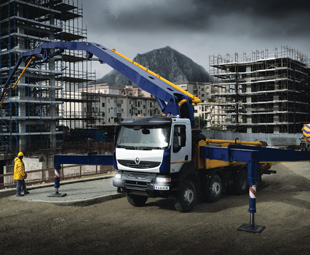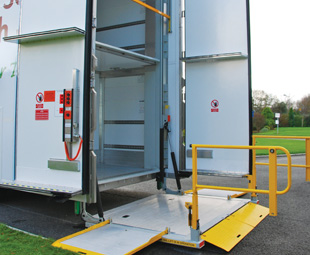Just lift it yourself

Correctly and efficiently loading and unloading a vehicle is an important consideration for transport operators. Irish commercial magazine, Fleet, published this report.
The common purpose of all commercial vehicles is to load, transport and deliver goods, passengers or services. While problems can arise at any stage throughout the journey, problems and delays at the loading and unloading points are often the most frequent, and many of these problems are out of the operator’s control.
The solution may be for operators to take back control of the loading and unloading, by using their own vehicle-mounted handling equipment.
Lifting equipment allows a great deal of flexibility and can increase vehicle utilisation by reducing wasted time at each end of the journey. This makes the economic argument quite clear; if a driver can deliver immediately without having to wait for equipment to become available, hours can be saved over the working day.
However, as with most aspects of the transport industry (and lifting equipment is no different) there are the ups and downs, so to speak. The pros of flexibility must be weighed against the cons of extra weight, additional maintenance and appropriate driver training to comply with health and safety requirements.
Interestingly, the fitment and use of lifting equipment is one that touches all sectors of the industry, from light vans to trailer operators, and includes the passenger transport sector. With all transport equipment, what you intend to do with it deserves serious consideration, and with handling equipment there are many issues to consider – not least lifting capacity.
Lifting capacity is obviously important, though some transporters are finding that customers are under-declaring the weight of pallets, and that pallet sizes are increasing as customers try to save on transport costs.
This has the potential to be more than just a slight deception on the customer’s behalf – it can be inherently dangerous. If the stated weight exceeds the rated Safe Working Load (SWL) of the lift, the consequences could prove expensive at best, or in the worst case result in personal injury.
One thing new-dimension equipment providers have to deal with is the fitment of tail-lifts to double-deck trailers. While not the most common of applications, they are becoming more frequent. In general the same rules and operational procedures apply. However, due to the increase in working height, any potential dangers and hazards are greatly exaggerated and, therefore, potentially more serious.
 In the drive to save weight, increase payload and save fuel, rear-closure tail lifts have increased in popularity. Ballinlough Refrigeration has supplied the highly regarded DHollandia brand of tail lift products for almost twenty years.
In the drive to save weight, increase payload and save fuel, rear-closure tail lifts have increased in popularity. Ballinlough Refrigeration has supplied the highly regarded DHollandia brand of tail lift products for almost twenty years.
Ballinlough’s Neil Bannon explains: “The main benefit of rear-closure models is that they eliminate the need for rear doors or a roller shutter. Because the platform itself becomes the rear frame and doors, it seals the cargo bay. Using the tail-lift platform as the rear frame delivers the weight reduction, and is of particular benefit for the weight-sensitive light commercials.”
Bannon adds: “The units are easy to fit and simple to operate, making them flexible and cost effective.” He also notes the additional benefits for vehicle security the rear closure model offers.
Another respected name in the supply of tail-lift equipment is Zepro. TSS Refrigeration & Tail Lifts is the Irish agent for Zepro, and the brand has proved popular with operators due to its reliability and durability. The Zepro range will adapt to most regular vehicles on the market. TSS offers a wide range of accessories that will adapt the lift to an operator’s specific needs.
TSS’s Mark Grange says: “We always strive to reduce the weight of our products to keep the fuel consumption to a minimum, to save both money and to reduce the effect on the environment.”
Grange points out that regular maintenance is necessary to ensure trouble-free operation, as any downtime of the tail lift can mean downtime of the whole vehicle. “TSS provides a comprehensive parts service. We have complete archives to assist quickly and accurately with spare-part requirements,” adds Grange.
To reduce the risk of accidents, a driver or operator of truck-mounted tail lift should be correctly trained and certified on the specific piece of equipment. However, due to the wide range of vehicle attachments and operational environments, some training companies recommend that operators undergo training from the original equipment supplier. Their reasoning is that, because of variations in delivery points, it is almost impossible to cover all possibilities.
Another widely used type of self-lifting equipment is the truck-mounted crane. It has long been a regular feature in certain segments of transport, in particular on the construction supply side.
A global supplier of cranes across all industry sectors is Palfinger, which this year celebrated 50 years in business. The Palfinger product range covers small access platforms, tail lifts, truck-mounted and off-shore marine cranes.
The company offers a vast range of attachments for its cranes, which greatly widens the scope of applications for which any one crane (and therefore truck) can be used.
Seamus Kane of Palfinger Ireland notes: “The training situation for truck-mounted cranes is slightly different from some other transport equipment.” Palfinger also supplies a selection of truck-mounted forklifts and remotely operated lift trucks. The truck-mounted forklift is an alternative to a crane or tail lift.
Always having the ability to deliver the load can dramatically improve vehicle productivity. Although the initial cost can be off-putting for some operators, the longevity of the equipment must be considered. In real terms the part-time operation cycle is generally not as tough as that experienced by a full-time forklift, in that a smaller percentage of the time is spent working.
Selecting the right model from a recognised company like Manitou (with its highly versatile TMT range) ensures the unit will remain in service for a long time. As a rule, once operated within its design specification, and provided the unit is properly maintained, it should operate trouble free over the lifetime of two or more of the trucks on which it is carried.
Moffett Engineering began manufacturing in Dundalk in the 1940s and changed the face of the transport industry when it mounted a small forklift to a truck in the 1980s. The company is now part of the Cargotec Corporation.
The Moffett truck-mounted forklift became a synonym for this type of equipment and was an Irish engineering success on a global scale. The three-wheeled units have a lifting capacity from 1,5 to 3,5 t. They can be equipped with a variety of attachments, which allow them to be used in almost every industry.
Within the Cargotec Corporation the Moffett brand sits alongside other company names such as Hiab, Kalmar and McGregor.
It is important to note that once a truck-mounted forklift is detached from the carrying vehicle, it becomes a standard forklift under the general applications regulations, and is subject to the normal rules governing this type of equipment. Employers have an obligation to ensure that drivers are properly trained to operate the forklift.
The issue of correct maintenance is an important factor for all truck-mounted forklifts, cranes and tail lifts. Proper maintenance checks include the annual testing of equipment for correct operation of all components and a weight test.
One point brought to our attention is that, in addition to the annual test and certification, equipment that can carry a person (even inadvertently), should be serviced and checked tested every six months along with the annual test. All testing must be carried out by a recognised competent person.
All the major recognised brands of lifting devices appear to retain a high residual value and there always seems to be a market for well-maintained used equipment. In most cases lifting units can be transferred from one vehicle to another. Equipment that is operated within capacity, remains undamaged and is maintained correctly, can significantly add to a vehicle’s value.
For some operators (depending on the nature of the work) lifting equipment is an absolute necessity, as there is often no alternative method of unloading at the delivery point. The benefits of self-lifting devices, in terms of improved vehicle utilisation and driver productivity, can dramatically outweigh the investment.
As regular readers of FOCUS know, this magazine has been appointed an associate member of the International Truck of the Year (IToY)! FOCUS is the sole South African magazine to have joined this prestigious body. One of the advantages of this association is access to exclusive articles, specially written for FOCUS by ITOY jury members. This is one such article.
Published by
Focus on Transport
focusmagsa




